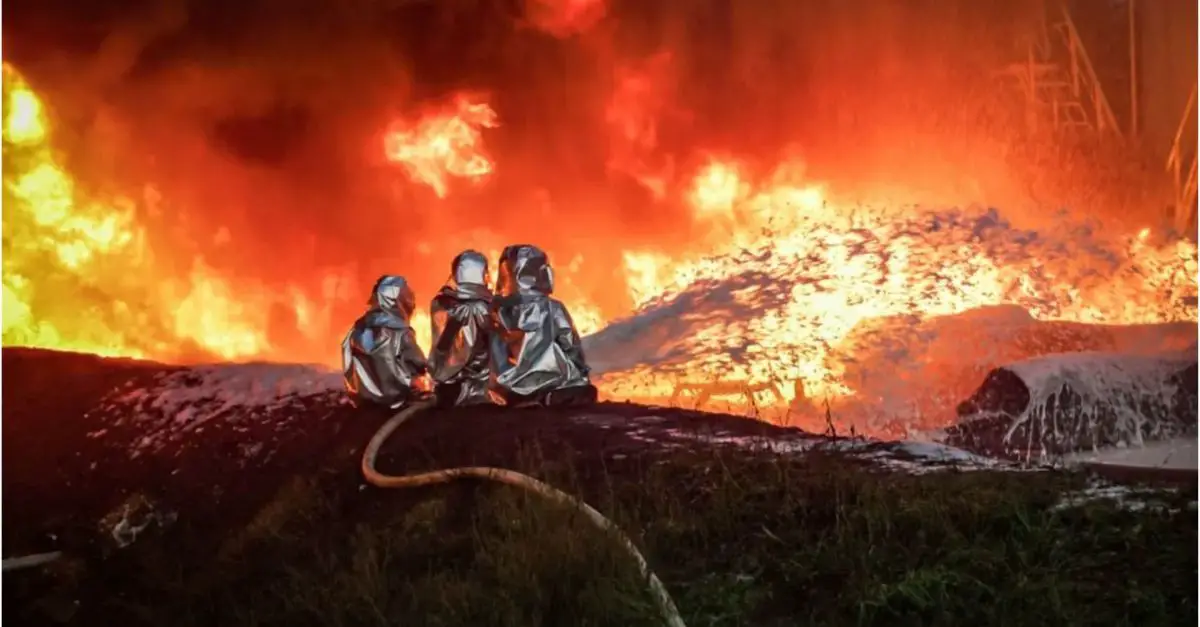Breaking News
Russian attack on Ternopil region: Chlorine levels in air strongly increase.
An excess of chlorine levels in the air has been recorded in the western region of Ternopil, Ukraine, due to a fire at an industrial facility following a Russian attack. Oksana Chaichuk, General Director of the Ternopil Regional Center for Disease Control and Prevention of the Ukrainian Ministry of Health, made this statement during a briefing on Tuesday, according to a correspondent from Ukrinform.
Follow Army Recognition on Google News at this link

Emergency responder using chemicals to reduce fire due to russian attack on ternopil (Picture source: Ukrainian Emercom)
The official standard in Europe is 0.1 milligrams per cubic meter of air, but in Ternopil, chlorine levels range from 0.4 to 1.01 milligrams per cubic meter. This means the concentration in the atmospheric air is four to ten times higher than the norm.
As a result, residents of Ternopil are advised to limit their time outdoors and restrict the entry of atmospheric air into closed spaces. If possible, use an air recuperator. Cover windows and doors with damp sheets to prevent chlorine from entering the room. It is also recommended to avoid swimming in bodies of water and to stay away from them. Preschool employees are advised not to keep children inside these facilities. Parents are encouraged to remove their children from kindergartens and keep them at home until special recommendations are issued.
Meetings of commissions on anthropogenic and ecological safety and emergency situations have been urgently convened.
Chlorine is a toxic gas that can have devastating effects on the human body, even at relatively low concentrations. When inhaled, chlorine reacts with moisture in the respiratory tract to form hydrochloric acid and hypochlorous acid, both of which are highly corrosive compounds. These acids can cause severe irritation of the respiratory tract, coughing, breathing difficulties, and, in severe cases, pulmonary edema, which can be fatal without prompt treatment.
The minimum lethal dose of inhaled chlorine varies depending on the concentration and duration of exposure. Generally, a concentration of 430 parts per million (ppm) can be fatal after 30 minutes of exposure. At higher concentrations, such as 1000 ppm, chlorine can cause death within minutes. However, even at lower concentrations (1-10 ppm), prolonged exposure can cause significant damage to the lungs and other organs.
In addition to inhalation, chlorine can also cause severe chemical burns if it comes into direct contact with the skin or eyes. In such cases, it is essential to rinse the affected area with plenty of water immediately to minimize damage. Generally, any significant exposure to chlorine requires immediate medical attention to prevent severe health consequences.
At present, the concentrations are not particularly lethal, as it takes approximately 430 ppm of chlorine concentration to be fatal, but today's concentration is 0.35 ppm, which is 100 times lower than the lethal dose for prolonged exposure. However, chlorine is a relatively insidious chemical compound because, even at very low doses, without respiratory protection or treatment, it can cause discomfort or lung damage over the long term. For the record, chlorine was one of the first combat gases used during World War I.
In response to these strikes, Ukraine has officially requested assistance from NATO for fire trucks, excavators, and armored ambulances, all for civilian use.


























